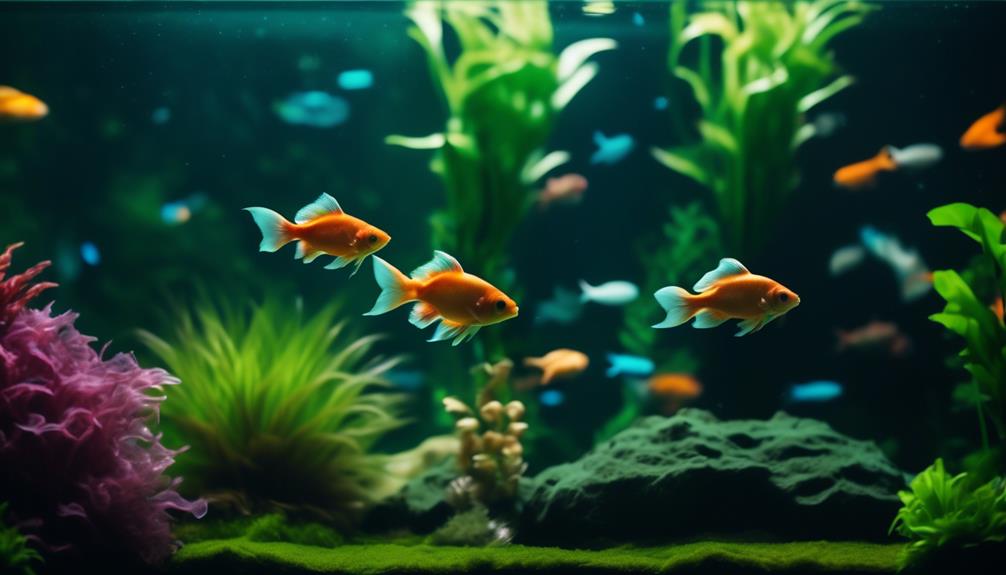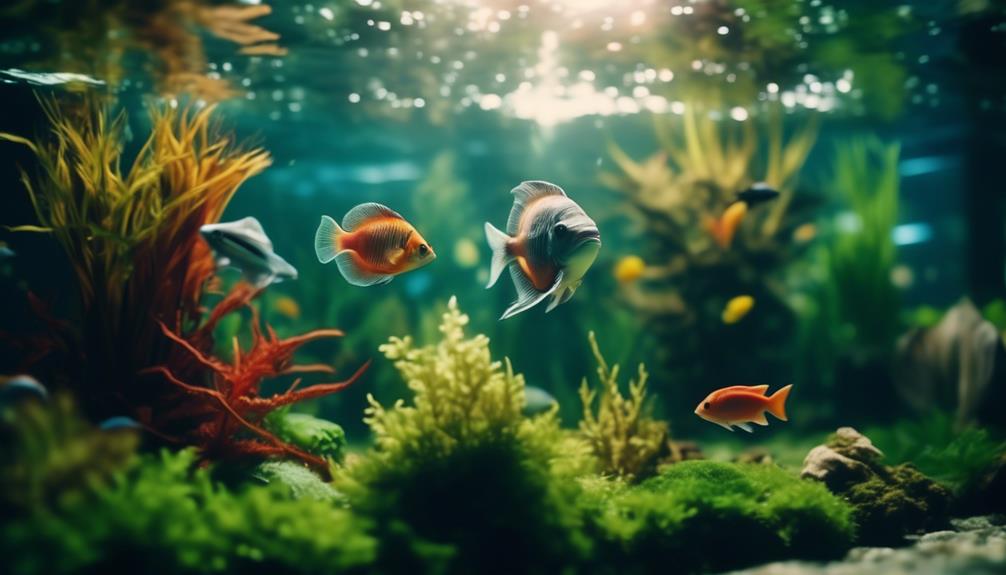Like a delicate dance, stocking your aquarium requires finding the perfect balance that will keep your aquatic ecosystem thriving.
But fear not, for in this article, we will unravel the secrets that will help you achieve this elusive equilibrium. From managing waste load to considering aggression and compatibility, we will explore the key factors that influence stocking levels.
By understanding the importance of filtration, swimming space, and the temperament of your fish, you can create a harmonious environment that promotes their health and well-being.
But that's not all – we will also provide practical tips on determining the right stocking level and uncover the benefits of understocking and adaptation.
So, get ready to embark on this journey with us and unlock the secrets to the perfect balance in aquarium stocking.
Key Takeaways
- Adequate filtration and waste management are crucial for maintaining water quality in an aquarium.
- Consider the swimming space requirements and maximum size of fish when determining stocking levels.
- Take into account the aggression level and compatibility of fish species when choosing tank mates.
- Start with understocking the aquarium and gradually add more fish over time to allow for ecosystem adaptation.
Factors Affecting Stocking Levels
To ensure a healthy and balanced aquatic environment, it's crucial to consider several factors that affect stocking levels in your aquarium.
Water quality plays a vital role in the well-being of your fish. Adequate filtration is essential for the growth of beneficial bacteria and the breakdown of waste compounds. It's important to choose filtration appropriate for the size of your aquarium.
Additionally, maintaining water quality can be aided by incorporating live aquarium plants that consume nitrogen compounds and reduce toxic waste.
Fish compatibility is another significant factor. Consider the aggression level, size, and activity requirements of the fish species when choosing tank mates. Providing enough space and decorations to break up the line of sight can help establish territories and prevent aggression.
Aggression and Compatibility
Consider the aggression level and compatibility of the fish species to ensure a harmonious and peaceful aquarium environment. Aggression management and choosing tank mates are crucial aspects of maintaining a balanced aquarium. Here are four key points to keep in mind:
- Provide enough space and decorations to break up the line of sight and establish territories. This helps reduce aggression between fish.
- Choose tank mates that swim in different layers of the aquarium to avoid aggression. This allows each fish to have its own space and reduces competition.
- African cichlids may require more fish and decreased swimming space to prevent territorial disputes. Research the specific needs of this species before adding them to your tank.
- Betta fish may get aggressive towards fish swimming near the surface, so choose tank mates that stay in different areas. This prevents conflict and promotes a peaceful coexistence.
How to Determine the Right Stocking Level

Determining the right stocking level for your aquarium requires careful consideration of water quality, fish compatibility, and the specific needs of each fish species.
To determine the stocking level, you should measure nitrate levels regularly. Nitrate is a byproduct of fish waste and excessive levels can be harmful to fish.
Regular water changes are important for maintaining water quality and reducing nitrate levels. Water changes help remove accumulated toxins and replenish essential minerals.
It's recommended to choose a set frequency for water changes based on the size of your aquarium and the number of fish.
Understocking and Adaptation
Understocking the aquarium initially is recommended to allow for the gradual adaptation of the beneficial bacteria colony and the establishment of a stable ecosystem. This approach offers several benefits in aquariums:
- Reduced Stress: Understocking provides ample swimming space for the fish, reducing stress levels and promoting overall well-being.
- Water Quality Maintenance: With fewer fish, the waste load is lower, allowing the filtration system to effectively process waste compounds and maintain high water quality.
- Increased Flexibility: Understocking allows room for future additions, whether it be more fish or additional plants. This flexibility enables you to adapt to changes in your stocking levels as fish breed or plants grow.
- Easier Maintenance: With fewer fish, maintaining water parameters becomes easier, saving you time and effort in regular maintenance tasks.
Subscription and Blog Posts

To stay up to date with the latest aquarium tips and tricks, receive exclusive offers, and join a community of aquarium enthusiasts, subscribing to our weekly blog articles via email is the perfect way to enhance your aquarium knowledge.
By subscribing, you'll gain access to valuable information on choosing tank mates for your aquarium. Joining our community of aquarium enthusiasts will allow you to connect with others who share your passion and learn from their experiences.
Our blog posts will provide you with detailed insights on the compatibility of different fish species, their temperament, and their size, ensuring that you can create a harmonious and thriving aquarium environment.
Don't miss out on this opportunity to expand your knowledge and make informed decisions when choosing tank mates for your aquarium. Subscribe now and become a part of our vibrant aquarium community.
Frequently Asked Questions
How Often Should I Feed My Fish and What Type of Food Should I Give Them?
You should feed your fish once or twice a day, providing a balanced diet of high-quality fish food. Choose options like flakes, pellets, or frozen foods that are suitable for the species and size of your fish.
Can I Keep Different Species of Fish Together in the Same Tank?
Yes, you can keep different species of fish together in the same tank. It's called tank compatibility. Doing so can create a dynamic and diverse ecosystem, benefiting the overall health and balance of the aquarium.
How Can I Prevent Overstocking My Aquarium and Maintain Water Quality?
To prevent overstocking and maintain water quality, choose the right filtration system for your aquarium and regularly test the water. This ensures efficient waste breakdown and optimal conditions for your fish.
Are There Any Specific Plants or Decorations That Can Help Reduce Aggression Among Fish?
To reduce aggression in fish, consider adding plants like Anubias, Java Fern, or Amazon Sword. These provide hiding spots and break line of sight. Decorations like driftwood or rock formations can also create territorial boundaries, minimizing conflicts among fish.
What Are Some Signs That Indicate My Aquarium Is Overstocked?
If your aquarium is overstocked, signs include poor water quality, high nitrate levels, stressed fish, and increased aggression. Overstocking can negatively impact water quality, leading to fish health issues and a disrupted ecosystem.
Conclusion
In conclusion, achieving the perfect balance in stocking your aquarium requires careful consideration of factors such as waste load management, aggression and compatibility, filtration, swimming space, and the temperament of your fish.
By understanding these key factors and determining the right stocking level, you can create a harmonious environment that promotes the health and well-being of your aquatic companions.
Embracing understocking and allowing for adaptation will also ensure the long-term success of your underwater world.
So dive in and unlock the secrets to a thriving aquarium today.

